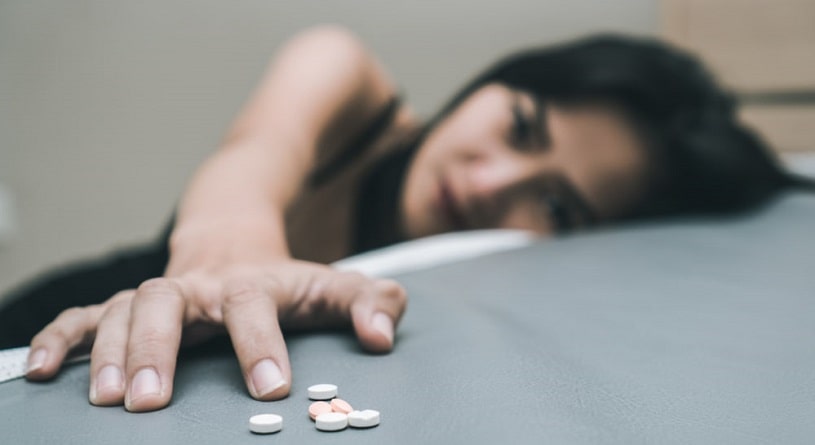Klonopin, also known as Clonazepam, is a benzodiazepine. These drugs enhance the effect of neurotransmitter receptors in the brain to treat health conditions like epilepsy and anxiety. However, benzodiazepines, including Clonazepam, can be addictive and can have significant withdrawal symptoms when abstaining. This article will discuss Klonopin use and abuse, addiction, and withdrawal.
Table Of Contents:
- What is Clonazepam?
- What Is This Drug Used for?
- Is This Medicine Addictive?
- What Is the Scope of Abuse?
- What Are the Addiction Signs?
- What Is Clonazepam Withdrawal?
- What Is the Timeline for Withdrawal?
- What Are the Dangers of Withdrawal From This Medication?
- How Can This Addiction Be Treated?
- When to Start Treatment?

What is Klonopin?
Klonopin is a brand name for the benzodiazepine Clonazepam. It is a strong sedative that acts on the central nervous system to effectively slow the brain’s activity. This makes it highly effective in the treatment of anxiety as it sedates and slows down mental processes, calming the individual down.

More About Benzodiazepines:
Although this is a plus for extreme anxiety, these properties also make it highly addictive and habit-forming. Use of Clonazepam longer than four weeks often leads to dependence, Klonopin withdrawal, and other troubling side effects to health.
The Controlled Substances Act classifies Clonazepam as a Schedule IV drug. Although the drug has some known and medically accepted uses, it still has addictive properties that pose a danger to the public. When a person takes it recreationally, they run the risk of building tolerance and thus moving to higher doses. Tolerance occurs when the receptors in the brain can no longer be affected by lower doses. This leads to the consumption of higher doses of Clonazepam and building subsequent greater tolerance. Over time, this develops into a habit that requires specialized treatment.
Those with severe anxiety or panic disorders may take more than recommended or take the drug longer than advised if other prescription drugs fail to have the same calming effects against their symptoms. It is usually only prescribed to those with severe and debilitating anxiety disorders for these reasons.
Klonopin Uses
Clonazepam slows down the function of the central nervous system. It does this by augmenting the effect of certain neurotransmitter receptors in the brain, known as GABA receptors. Klonopin uses this to produce its effects. These Klonopin effects make it a perfect treatment for anxiety.
Clonazepam for Sleep
Clonazepam, like a benzodiazepine, has a hypnotic effect. This refers to any drug that can induce sleep.
Clonazepam for sleep disorders such as insomnia is an off-label use. It is not FDA-approved for this purpose.
Benzodiazepines attach to GABA, or gamma-aminobutyric acid, receptors. This neurotransmitter is the major inhibitory substance in the CNS, and when it attaches to its receptors, it is highly involved in the induction of sleep. Clonazepam increases the effect of GABA on its receptors, helping induce sleep.
Klonopin for Anxiety
Panic disorders are a form of anxiety disorder, and Klonopin is approved by the FDA to be used in their treatment. This is one of the foremost Klonopin uses.
The enhancement of the effect of GABA on its receptors is still the underlying mechanism behind how this drug is effective in the treatment of anxiety. The main factor here is the location that it acts in the CNS.
The anxiolytic effect is caused by the drug’s action on the GABA receptors in the limbic system.
Clonazepam for Seizures
Another of the FDA-approved Klonopin uses is in the treatment of epilepsy and other seizure disorders. Seizure and panic disorders are the only two uses approved by the FDA.
The manner by which the medication can provide an anti-epileptic effect is not fully understood. However, binding to GABA receptors and enhancement of its effects are thought to be the primary culprit.
Is Klonopin Addictive?
Benzodiazepines are well known to be substances with the risk of addiction. Clonazepam is no different, which explains why this drug is a Schedule IV drug. It is prescribed sparingly and for relatively short periods of time to avoid Klonopin addiction and the health risk.

The mechanism behind this has been made more evident over the years. It is similar to the mechanism involving dopamine seen for drugs such as opioids, but Klonopin uses a slightly different path. When a benzodiazepine such as Clonazepam is taken, it interacts with what is known as inhibitory interneurons. Under normal circumstances, these cells prevent dopamine levels from rising excessively by inhibiting the frequency of neurons that produce it.
However, what makes benzodiazepines a little different is that they inhibit these neurons that normally exhibit. As a result, they remove the control that these interneurons have over these dopamine-producing neurons, and the levels are allowed to spike.
These increased levels of dopamine can induce what is known as plasticity, where the neurons become used to the higher levels of the substance and no longer function effectively at lower values.
The amount of time it takes for Klonopin addiction to develop is not solid. It depends on the dosage being used, how frequently, and genetic factors such as predisposition to addiction. However, it can take as little as a few weeks.
Clonazepam Statistics
Clonazepam was the second most prescribed benzodiazepine in 2018, only behind alprazolam. There were over 17 million prescriptions of the drug made in that year.
In the 2019 National Survey on Drug Use and Health, 0.38% of respondents had misused this drug in the past year. Weighted for the whole nation, that comes to over 1 million people who abuse the drug every year. Its abuse is most prominent in those between the ages of 18 and 34, but 25 to 34 specifically.
In 2011 alone, over 75,000 people were admitted to emergency rooms based on abuse of Clonazepam. It is more likely when Clonazepam is mixed with other drugs, like alcohol. Alcohol is a common commodity for those in the age group with the most prevalence, increasing the risk.
Just a few years prior, in 2008, 60,000 people were admitted for treatment of benzodiazepine addiction, including Klonopin addiction.
Warning Signs Of Clonazepam Addiction
There are numerous signs to look out for if one believes that a loved one may be using Klonopin in an abusive way. Since some users are also using another drug or alcohol, symptoms not associated with Clonazepam directly may also present themselves, so it’s good to know the more common drug abuse signs for all drugs.
The symptoms of Klonopin addiction can be divided into physical and behavioral signs.
The Physical Signs Include the Following:
- Staggering gait
- Bloodshot eyes
- Nausea
- Vomiting
- Headache
- Weight loss
- Poor hygiene
- Nosebleeds (epistaxis)
The Behavioral Signs Include:
- Personality changes or mood swings
- Irritability
- Aggression
- Confusion
- Sudden loss of interest in hobbies
- Loss of appetite
- Cognitive impairment
- Secretive behavior
- Poor performance in school or at work
If someone has an addiction to this or another drug, contact a licensed drug addiction therapist for further instruction on how to seek treatment.
Klonopin Withdrawal
As with many different drugs, whatever the drug was used to combat, it comes back worse during the withdrawal period. So, if patients were taking it for a panic disorder, they may experience extreme states of panic during the Clonazepam withdrawal period. This is also why medical oversight is crucial when undergoing Clonazepam detox. For example, with its use as a seizure medication, seizures can return when the drug is set aside.

Clonazepam withdrawal symptoms can be cognitive (confusion and memory loss), somatic (headaches and flu-like symptoms), gastrointestinal (cramps and vomiting), and cardiac (increased heart rate). Klonopin withdrawal symptoms are commonly divided into two categories; physical and psychological.
Physical Klonopin Withdrawal Symptoms Include the Following:
- Nausea and vomiting
- Fever
- Hallucinations
- Irritability
- Coordination problems and dizziness
- Insomnia
- Anxiety
- Seizures
- Sweating
- Tremors
- Increased heart rate
The psychological effects of Klonopin withdrawal often occur later on, after the physical symptoms have set in, during the acute phase. These symptoms can be severe and may require further psychological treatment and support.
They May Include:
- Panic
- Anxiety
- Depression and/suicidal thoughts
- Hostility or aggression
- Confusion
- Irritability
- Intense and vivid dreams
- Drug cravings
- Insomnia
Klonopin Withdrawal Timeline
The timeline for Klonopin withdrawal symptoms depends on many individual factors but can range from one week to a few months. The length and severity of Klonopin withdrawal symptoms depend on the history of abuse (period and dosage) and lifestyle differences (other drugs and health). Klonopin withdrawal is classified into three phases: early, acute and post-acute.
The Early Phase
The early phase begins when the drug leaves the bloodstream and is characterized by panic attacks, anxiety, seizures, and insomnia. These symptoms are the conditions that this drug was supposed to treat in the first place. Clonazepam has a long half-life, and the early phase symptoms may be experienced from 2 to 4 days after the last intake of the substance.
The Acute Phase
The acute phase starts after the early period. It peaks two weeks after the drug intake has been stopped and can continue for a week and up to a few months.
Symptoms Include:
- Dizziness
- Headaches
- Tension
- Tremors
- Confusion
- Memory loss
- Hallucinations
- Change in appetite
- Seizures
The Post-Acute Phase
The last phase, post-acute, is not always clinically considered a part of the Klonopin withdrawal process, but some patients experience protracted symptoms such as depression, anxiety, and anhedonia. Studies have shown that some people feel some side effects and experience changes in their sleep patterns years after quitting.
Klonopin Withdrawal Dangers
When confronted with such an extensive list of symptoms associated with Klonopin withdrawal, this is a fair question. There are two situations in which Klonopin withdrawal may be deadly, but they are easily avoidable if the correct steps are taken.
The Danger of Seizures and Depression
The most significant risk occurs when Clonazepam is quit “cold turkey.” Klonopin withdrawal seizures can be severe and at times deadly, especially if experienced with no medical supervision. The second greatest risk during Klonopin withdrawal is mental health issues. As stated in the list of psychological symptoms, depression and suicidal thoughts often occur during this time. If left untreated, they significantly increase the risk of self-inflicted harm and even death.

On top of that, drug cravings may occur in the acute stage of Clonazepam withdrawal and can lead to dangerous drug experimentation, resulting in an overdose on Klonopin. Additionally, if someone is already struggling with multiple addictions and begins the Klonopin withdrawal process, they are at an increased risk of severe or even deadly seizures. This is especially true if someone detoxes from a benzodiazepine and an opiate (such as heroin) simultaneously.
The Importance of Treatment
All of this is preventable and highlights the importance of reaching out for help. People should not feel the need to quit “cold turkey” when there are medical programs and schedules to help slowly and safely taper off the substance at a rate that increases safety and well-being. Medical help of a detox center will also include the psychological support needed to help combat any depression or suicidal thoughts.
Tapering Off Methods
Clonazepam has a long half-life, and it takes approximately two days for the substance to leave the body’s bloodstream. Keep in mind that even small doses are enough to experience Clonazepam withdrawal that can last for months and even for years. Some users say that even 0.25 mg of Clonazepam is sufficient to knock out a user that’s not tolerant. It should be stopped slowly, and tapering off can last weeks. Quitting “cold turkey” should be avoided because, as previously mentioned, in some cases, it can cause potentially lethal seizures. Recovery via medically supervised means remains the best option.
Klonopin Addiction Treatment
Although Klonopin addiction can be extreme and debilitating, it is possible to find Klonopin addiction help. The first step to getting Klonopin addiction treatment is recognizing that the problem exists. This is the most critical point of the entire treatment process, as coming to this realization early can mean a quick recovery. Once identified, the person will have the option of taking up any treatment options available at a rehab facility. It is important to note that waiting can make drug abuse worse and harder to treat. Hence the need for immediate intervention as soon as the condition is identified. Other problems, such as alcohol abuse, will be addressed.
Places to Find Help for a Clonazepam Addiction
Drug addiction treatment methods include detox programs, counseling sessions, and peer support groups. It is best to enroll in an inpatient rehab facility where medical professionals can effectively manage the dangerous Clonazepam withdrawal and the Klonopin addiction and its underlying conditions.
It is usually more easily accomplished in inpatient substance abuse rehabilitation facilities.
Once detox has taken place, counseling and peer support are offered in a safe environment to help promote lasting change and recovery that will help users stay clean and sober over the long-term. These are usually followed by outpatient support groups and counseling with drug and alcohol addiction counseling specialists.
Starting Right Now
Klonopin addiction affects thousands of Americans each year. More get addicted each year while others are admitted to ERs for recovery across the country with benzodiazepine-related complications, especially when mixed with other drugs like alcohol. With a rising trend in use and abuse, anyone with the problem needs to turn around and head in the opposite direction towards help. Finding a new path that leads away from addiction and towards detox and recovery can be the turning point that changes the entire course of a person’s life. Klonopin addiction treatment and rehab is this new path. Do not wait for the problem to get worse; act today.
Hope Without Commitment
Find the best treatment options. Call our free and confidential helpline
Most private insurances accepted
Page Sources
- United States Drug Enforcement Agency, Controlled Substances Schedule, https://www.deadiversion.usdoj.gov/schedules/
- United Stated food and Drug Administration, KLONOPIN TABLETS (Clonazepam), 2013, https://www.accessdata.fda.gov/drugsatfda_docs/label/2013/017533s053,020813s009lbl.pdf
- Gottesmann C. (2002). GABA mechanisms and sleep. Neuroscience, 111(2), 231–239. https://pubmed.ncbi.nlm.nih.gov/11983310/
- National Institute of Mental Health, Anxiety Disorders, https://www.nimh.nih.gov/health/topics/anxiety-disorders/index.shtml
- Griffin, C. E., Kaye, A. M., Bueno, F. R., & Kaye, A. D. (2013). Benzodiazepine pharmacology and central nervous system–mediated effects. Ochsner Journal, 13(2), 214-223. https://www.ncbi.nlm.nih.gov/pmc/articles/PMC3684331/
- National Institute on Drug Abuse, Well-Known Mechanism Underlies Benzodiazepines' Addictive Properties, https://archives.drugabuse.gov/news-events/nida-notes/2012/04/well-known-mechanism-underlies-benzodiazepines-addictive-properties
- Ashton C. H. (1995). Protracted Withdrawal From Benzodiazepines: The Post-Withdrawal Syndrome. Psychiatric Annals, 25(3), 174-179. https://www.benzo.org.uk/pha-1.htm
- Wang, S. M., Kim, J. B., Sakong, J. K., Suh, H. S., Oh, K. S., Woo, J. M., ... & Lee, K. U. (2016). The efficacy and safety of Clonazepam in patients with anxiety disorder taking newer antidepressants: a multicenter naturalistic study. Clinical Psychopharmacology and Neuroscience, 14(2), 177. https://www.ncbi.nlm.nih.gov/pmc/articles/PMC4857865/
- Kacirova, I., Grundmann, M., Silhan, P., & Brozmanova, H. (2016). A case report of Clonazepam dependence: utilization of therapeutic drug monitoring during withdrawal period. Medicine, 95(9). https://www.ncbi.nlm.nih.gov/pmc/articles/PMC4782857/
- Olfson, M., King, M., & Schoenbaum, M. (2015). Benzodiazepine use in the United States. JAMA psychiatry, 72(2), 136–142. https://www.ncbi.nlm.nih.gov/pubmed/25517224
- Nardi, A. E., Freire, R. C., Valença, A. M., Amrein, R., de Cerqueira, A. C. R., Lopes, F. L., ... & Versiani, M. (2010). Tapering Clonazepam in patients with panic disorder after at least 3 years of treatment. Journal of clinical psychopharmacology, 30(3), 290-293. https://www.ncbi.nlm.nih.gov/pubmed/20473065
- Petursson, H. (1994). The benzodiazepine withdrawal syndrome. Addiction, 89(11), 1455-1459. https://www.ncbi.nlm.nih.gov/pubmed/7841856
- Ashton, H. (1991). Protracted withdrawal syndromes from benzodiazepines. Journal of substance abuse treatment, 8(1-2), 19-28. https://pubmed.ncbi.nlm.nih.gov/1675688/

 Authored by
Authored by  Reviewed by
Reviewed by 
